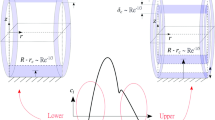Abstract
The developing flow in a semi-infinite pipe is solved for by an eigenfunction method. The results are applicable to zero and low Reynolds number flows. The eigenfunction method yields a solution which accurately predicts overshoots in the axial velocity for small axial positions. Results are presented for both uniform and non-uniform inlet conditions. The latter condition has important implications for numerical simulations of the developing flow problem.
Similar content being viewed by others
6. References
J. Gillis and A. Brandt, The Numerical integration of the equations of motion of a viscous fluid. AF EOAR, SR 63–73 (1964).
M. Friedmann, J. Gillis and N. Liron, Laminar flow in a pipe at low and moderate Reynolds numbers. Appl. Sci. Res. 19 (1968) 426–438.
M.H. Wagner, Developing flow in circular conduits: transition from plug flow to tube flow. J. Fluid Mech. 72 (1975) 257–268.
S. Arbarbanel, S. Bennett, A. Brandt and J. Gillis, Velocity profiles of flow at low Reynolds numbers. J. Appl. Mech. 37 (1970) 2–4.
L.C. Li and G.S.S. Ludford, The overshoot in entry flow. Arch. Mech. 32 (1980) 741–746.
J.L. Duda and J.S. Vrentas, Inviscid flow through a sudden contraction. IEC Fundam. 11 (1972) 590–593.
L.H. Benson, Velocity and thermal development in a pipe for low Reynolds number. M.S. Thesis, Clarkson College (1983).
J.Y. Yoo and D.D. Joseph, Stokes flow in a trench between concentric cylinders. SIAM J. Appl. Math. 34 (1978) 247–285.
R.D. Gregory, Green's functions, bi-linear forms, and completeness of the eigenfunctions for the elastostatic strip and wedge. J. Elast. 9 (1979) 283–309.
R.D. Gregory, The semi-infinite strip x⩾0, −1⩽y⩽1; completeness of the Papkovich-Fadle eigenfunctions when φ xx (0, y), φ yy (0, y) are prescribed. J. Elast. 10 (1980) 57–80.
R.D. Gregory, The traction boundary value problem for the elastostatic semi-infinite strip; existence of solution, and completeness of the Papkovich-Fadle eigenfunctions. J. Elast. 10 (1980) 295–327.
D.D. Joseph, L.D. Sturges and W.H. Warner, Convergence of biorthogonal series of biharmonic eigenfunctions by the method of Titchmarsh. Arch. Rat. Mech. Anal. 78 (1982) 223–274.
J.P. Benthem, A Laplace transform method for the solution of semi-finite and finite strip problems in stress analysis. Quart. J. Mech. and Appl. Math. 16 (1963) 413–429.
S.A. Trogdon and D.D. Joseph, The stick-slip problem for a round jet I: large surface tension. Rheol. Acta. 19 (1980) 404–420.
S.A. Trogdon and D.D. Joseph, The stick-slip problem for a round jet II: small surface tension. Rheol. Acta. 20 (1981) 1–13.
Author information
Authors and Affiliations
Additional information
This research was performed while Mr Benson was a graduate student at Clarkson College, Potsdam, NY, USA.
Rights and permissions
About this article
Cite this article
Benson, L.H., Trogdon, S.A. An eigenfunction solution of entry flow in a semi-infinite pipe at low Reynolds numbers. Appl. Sci. Res. 42, 347–359 (1985). https://doi.org/10.1007/BF00384212
Accepted:
Issue Date:
DOI: https://doi.org/10.1007/BF00384212



